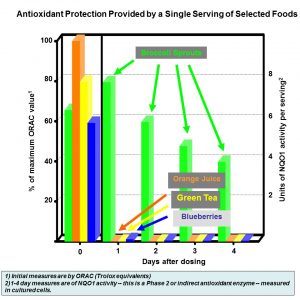Over the years many people have asked what we mean when we call sulforaphane an “indirect antioxidant”. We have just posted a FAQ entry that we hope helps to answer that question. Here is our answer:
Q: You and others frequently call sulforaphane an indirect antioxidant. What does that mean?
A: Oxidative stress is thought to be at the root of many diseases and pathologies OR to be a consequence of those conditions OR both.
Many classic antioxidants (e.g. vitamin C, tocopherols or vitamin E, and beta carotene) act directly by terminating chain reactions initiated by free radicals or by directly quenching oxidants or reactive oxygen species. These are direct antioxidants – they directly, and sacrificially prevent oxidation.
In contrast, sulforaphane induces or up-regulates a very wide range of protective enzymes in the body. Many of these are directly involved in countering oxidative stress. These include the enzymes controlling production of the body’s most ubiquitous and concentrated antioxidant, glutathione (or GSH). Sulforaphane does not directly quench or inhibit oxidation since it is not have what chemists call “redox activity”. Rather, it enhances and increases many [direct] antioxidants that in turn protect cells from oxidative stress. Thus, we call sulforaphane an indirect antioxidant.
 The immediate and direct antioxidant power of one serving of broccoli sprouts is similar to one serving of orange juice, green tea, or blueberries (0 days; left panel). One day later, sulforaphane-rich broccoli sprouts are very powerful indirect antioxidants (8 million units per serving; right panel). In contrast, the other foods retain only very weak indirect antioxidant activity (thousands of units per serving). Notably, broccoli sprouts still retain one half of their high indirect antioxidant potency, even 96 hours later.
The immediate and direct antioxidant power of one serving of broccoli sprouts is similar to one serving of orange juice, green tea, or blueberries (0 days; left panel). One day later, sulforaphane-rich broccoli sprouts are very powerful indirect antioxidants (8 million units per serving; right panel). In contrast, the other foods retain only very weak indirect antioxidant activity (thousands of units per serving). Notably, broccoli sprouts still retain one half of their high indirect antioxidant potency, even 96 hours later.
- The Passing of a Scientific Giant - March 15, 2019
- Moringa and the Cullman Center in the News Again - December 15, 2018
- December Newsletter Now Available - December 10, 2018